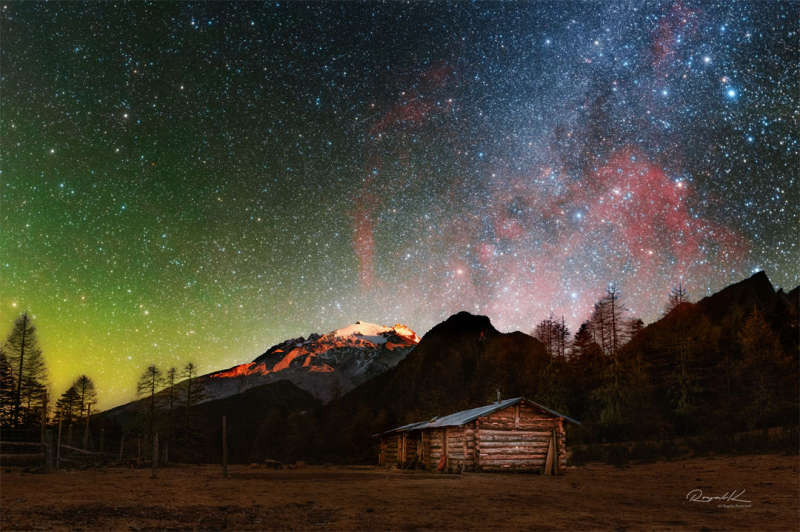Credit & Copyright: Wang Jin
Explanation:
The Gum Nebula is so large and close it is actually
hard to see.
This interstellar expanse of glowing
hydrogen gas frequently evades
notice because it spans 35 degrees -- over 70 full Moons -- while much of it is quite
dim.
This featured spectacular 90-degree wide mosaic, however, was designed to be
both wide and deep enough to bring up
the Gum -- visible in red on the right.
The image was acquired late last year with both the
foreground -- including
Haba Snow Mountain -- and the background
-- including the
Milky Way's central band --
captured by the same camera
and from the same location in
Shangri-La,
Yunnan,
China.
The Gum Nebula is so close that we are only about
450 light-years
from the front edge, while about 1,500 light-years
from the back edge.
Named for a cosmic cloud hunter, Australian astronomer
Colin Stanley Gum
(1924-1960), the origin of this
complex
nebula is still being debated.
A leading theory for the origin of the
Gum Nebula is that
it is the remnant of a million year-old
supernova explosion,
while a competing theory holds that
the Gum is a
molecular cloud
shaped over eons by multiple supernovas and the outflowing
winds of several massive stars.
1998 1999 2000 2001 2002 2003 2004 2005 2006 2007 2008 2009 2010 2011 2012 2013 2014 2015 2016 2017 2018 2019 2020 2021 2022 2023 2024 |
Январь Февраль Март Апрель Май Июнь Июль Август Сентябрь Октябрь Ноябрь Декабрь |
NASA Web Site Statements, Warnings, and Disclaimers
NASA Official: Jay Norris. Specific rights apply.
A service of: LHEA at NASA / GSFC
& Michigan Tech. U.
|
Публикации с ключевыми словами:
supernova remnant - остаток Сверхновой - эмиссионная туманность
Публикации со словами: supernova remnant - остаток Сверхновой - эмиссионная туманность | |
См. также:
Все публикации на ту же тему >> | |
